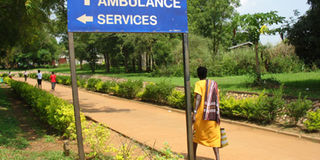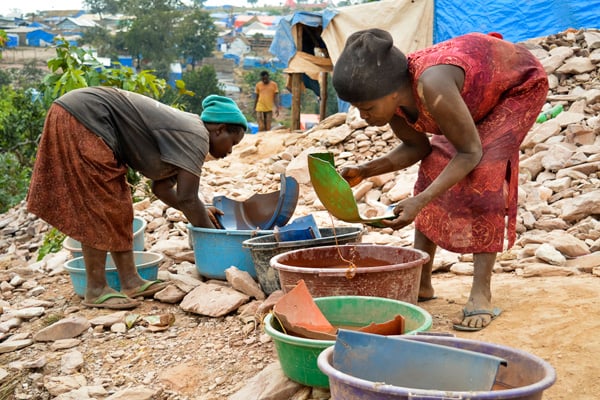Prime
Adjumani: The hospital others can borrow a leaf from

The road leading to Adjumani hospital. There has been an improvement in cleanliness. Photo by Martin Okudi
What you need to know:
Stories about government hospitals have recently held bad news, highlighting what is wrong at these health centres. But for Adjumani Hospital, the story is not so dire, illustrating that there is still hope for public hospitals
The small town of Adjumani District is characterised by dusty, potholed roads and a people still healing from the wounds of the 20-year-old Lord’s Resistance Army war.
The thin scanty road leading to the main town tells of years of unaccustomed usage and the innately decorated huts by the roadside give away the depths of the pockets of the residents. The lack of vegetation confirms the feeling that this is a dry land, it doesn’t help that the few trees have been burnt down for charcoal production, to generate income.
The district is home to more than 400,000 people, including refugees from South Sudan, and a few immigrants seeking to earn a living away from home. The main town is no different from the countryside, a few posh hotels here and there plus the few metres of tarmack roads give hope that there is some development happening in the town after all.
First impressions of the hospital
As we make our way to the main hospital, we look for the usual stories that make headlines in the different country’s media outlets - poor service delivery, dirty environment, absent nurses and doctors, the list goes on.
But what meets the eye at the entrance of the hospital is far from the picture embedded in our minds.
A cemented clean driveway comes to sight, a few metres ahead; there are unused cars, one an ambulance in poor mechanical condition. Walking up the driveway, not a leaf or polythene bag is in sight. “Maybe they have just cleaned it,” I conclude.
There are few people waiting to be attended to, all calmly seated in rows and columns on hospital benches; a few nurses walk by, getting ready for the busy day ahead. Unlike the usual hospital air, we are met with fresh air.
“Maybe it is because they have just cleaned it,” I conclude once again.
But, the story is no different in the various wings of the hospital, clear sign posts mark the walk ways, it is 9am and the floors are clean.
“This is how the hospital looks everyday,” a nurse, whose tag identifies her as Violet, says.
A look into the maternity ward, the labour room, and children’s wing confirms the thought that has been forming in my mind when I first walked into the hospital, they are a clean lot.
Capacity of the hospital
Micheal Ojja, the hospital administrator, says the 16-year-old 100-bed capacity hospital owes its existence to the African Development Bank, which gave money to the government for its construction. Sitting on 7,807 square metres of land, the hospital caters for more than 200 patients a day, with the highest cases treated being malaria, respiratory infections and pneumonia. Patients include refugees from South Sudan and people from neighbouring districts such as Amuru, Moyo and Atiak, among others. On average, between seven and 10 babies are delivered daily.
Despite the influx of patients at the hospital, Adjumani is clean unlike other government-owned and managed hospitals in different parts of the country.
Anne Adunia, the Adjumani district health officer, says having a clean hospital is and should be a priority because it could as well be a source of other infections if it is not well catered for.
“A person can come with malaria and leave with another disease or infection, which is not good,” she explains. Because of this and the fact that they offer services to other districts, she says cleanliness is a priority.
HOW THEY DO IT
Hiring a cleaning contractor

The road leading to the Orthopedic Department and administration block of Adjumani Hospital. PHOTOS BY MARTIN OKUDI
Michael Ojja, the hospital administrator, says the facility requests the local government, through the procurement department, to hire a contractor to clean the hospital. They can identify a capable contractor or the hospital recommends one. This way, the responsibility of hiring and supervising the cleaners is taken away from the hospital administration and given to the procurement department and contractor respectively.
“It is up to the contractor to hire the required cleaners, pay and supervise them. As the hospital, we pay Shs2.5m per month to the contractor and the contractor can distribute it to cleaners. This makes work easy for us,” Ojja explains. There are 35 cleaners in total excluding the ones who clean the compound.
He adds that hiring a contractor is in line with the ministry guidelines for disbursing monies above Shs1m.
“According to the law, if you are to pay for a service above Shs1m, then you should hire a contractor to deliver the service so we are operating within the guidelines of the law.”
Enock Kusasira, the Mulago National Referral Hospital spokesperson, in a telephone interview, said Mulago also hires a contractor to keep the hospital clean. However, according to one of the patients in the hospital, Agnes Nakibuule, the hospital is far from clean.
Ojja attributes the inefficiency of contractors to them using fewer cleaners.
“Some hospitals have less than 15 cleaners doing the job. How do you think they will keep the hospital as clean as it ought to be?” he asks.
Frequent hospital inspections
Before the contractor is paid at the end of every month, Ojja says there is an inspection by the health inspector to ensure that the hospital is as clean as it ought to be.
“We hold regular meetings with the contractor to find out any challenges faced so that they can be helped to deliver as expected. But, we also have an inspector who sees if the hospital is as clean as it should be. If not, the contractor is not paid and we request the procurement department to hire another contractor,” he clarifies.
Anne Adunia, the Adjumani district health officer, says the constant inspection helps to deliver better services to the people because it also involves constant monitoring of the service delivery by the public itself.
“A programme on the radio called Stress Factor has people commenting on the different issues. In case it is mentioned by anyone that the hospital is not clean or lacks one thing or another, we take it seriously and ensure that the issue is addressed immediately,” she explains.
As a result, there has been staff motivation because the public commends the work done at the hospital, she adds.
For Mulago hospital, Kusasira says the hospital holds evaluation meetings every after three months in which they assess the work that the given contractor does.
“There is a parameter upon which they are assessed; they are marked with percentages and after that, they are advised to improve or if below standard, the contract is suspended even though this has not happened so far,” Kusasira explained.
Challenges
Despite its high points in terms of cleanliness, the hospital faces various challenges just like any other hospital.
Ojja says the Shs375m allocated to the hospital annually is not enough to cater for plumbing and electricity in the entire hospital. The number of patients is well above what the hospital can contain, especially since there is an influx with those from other districts plus the refugees.
Medicinies are usually finished before the end of the month so drug stock-outs are common.
Currently, the hired contractors are Corim Enterprise Limited.




